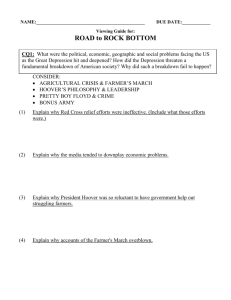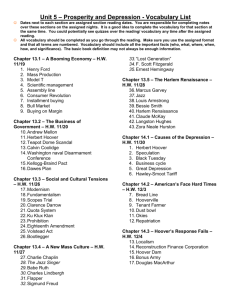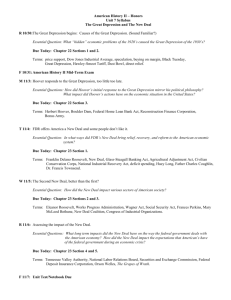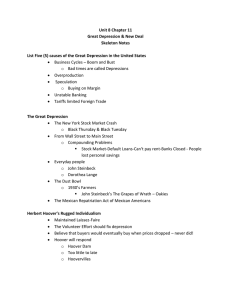The Great Depression & The New Deal
advertisement
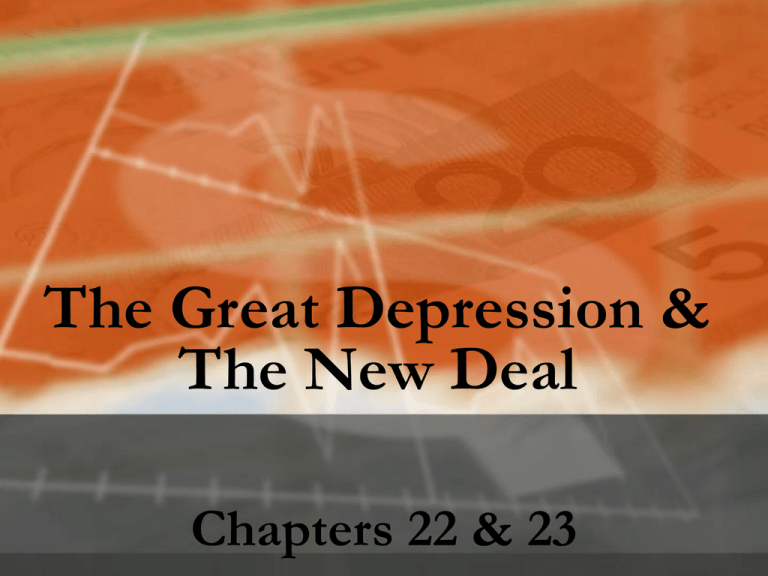
The Great Depression & The New Deal Chapters 22 & 23 Study for test! Chapters 17&18 STARTER: Thursday, November 30 Read pages 618-619 and answer the three questions below: • What was Roosevelt’s “Black Cabinet? What did it do? • Why didn’t Roosevelt support full civil rights for African Americans? • How did New Deal policies affect Native Americans? Read “Historical Spotlight: Deportation of Mexican Americans” on page 712 and answer the question below: • Why do you think Mexican Americans were met with hostility during the Depression? GROUP 3 Writers __________ __________ Radio Stars Writers __________ __________ Painters __________ __________ Movie Stars __________ __________ 1. 2. 3. 4. 1930-1939 Video What was the Bonus Army? What happened during Roosevelt’s first 100 days? How did Hitler violate the Treaty of Versailles? What was FDR’s stance on the war when World War II began in Europe? 5. What was life like in the cities during the Great Depression? 6. What segments of the population supported the President’s plan to get us out of the Great Depression? 7. What did the CCC do? 8. What was the Dust Bowl? 9. What group was most effected by the Great Depression? Why? 10. Who was John L. Lewis? 11. What games were played during the 30s? 12. How did Jesse Owens upset Hitler’s hopes for the 1936 Olympics? 13. Who was the first woman appointed to the cabinet? 14. What was the cause of the “crime crack down” of the 1930s? 15. Who was the most famous woman of the 1930s? Why? 16. What was the newsreel? 17. What was public reaction to “The War of the Worlds”? 18. Who was the most famous aviator of the 30s? 19. What did the Public Works Administration do? 20. What was the dance craze of the 30s? 4/23 • Test Corrections – Correct Answer – Why it is correct Starter • Read Causes of the Great Depression on pages 572-573 – Answer Two questions • Read Effects of the Great Depression on page 579 – Answer two questions If you were absent on Friday, Turn in your Great Depression/ New Deal Packet. It will not be accepted after 11:15 Starter • Imagine that I gave the class $1,000. Then we drove to Raleigh to eat at the Cheesecake Factory. • What would you buy to eat? • How would the restaurant respond to us coming? Starter • Read “The First 100 Days” along the bottoms of pages 602 and 603 – Answer the two Questions Starter • Assessment Sheets • Last Name- A-O on the Table • Last Name – P-W on the Cart Take out Great Depression/ New Deal Packet • Today I am checking: –Goal 8 Assessment Sheets –Midterm Assessment Sheets –9a Vocabulary –9a Assessment Sheet –9b Vocabulary –GD/ND Packet Objectives • 9.01 Elaborate on the cycle of economic boom and bust in the 1920's and 1930's. The Great Depression & The New Deal Packet Get to work on your packet! Due TODAY for a Quiz Grade COPY YOUR VOCABULARY Great Depression New Deal Vocabulary 1. Prosperity Due Monday 2. Warren G Harding 3. 4. 5. 6. 7. 8. 9. 10. 11. 12. 13. 14. 15. 16. 17. 18. 19. 20. 21. Calvin Coolidge Herbert Hoover Speculation Black Tuesday Business cycle Great Depression Hawley-Smoot Tariff John M Keynes Destitution Breadline Hoovervilles Cesar Chavez Dust Bowl Okies Depression Repatriation Localsim Trickledown economics Bonus army 22. 23. 24. 25. 26. 27. 28. 29. 30. 31. 32. 33. 34. 35. 36. Douglas Macarthur John Steinbeck Franklin D Roosevelt New Deal Fireside chats Federal Deposit Insurance Corporation Social Security Act Wagner Act Collective Bargaining Fair Labor Standards Act Black Deal Indian New Deal New Deal Coalition Welfare State Federal Art Project • ASSESSMENT SHEETS!!! Great Depression & New Deal Packet • • Assessment Sheet Vocabulary “What Would You Do?” Chapter 17, Section 1 Questions Chapter 17, Section 2 Chart Chapter 17, Section 3 Questions If you are finished, put this work in the basket If not, this is homework! STOP! You’re done! “What Would You Do?” It is 1929 and the U.S. economy has collapsed. Farms, businesses, and banks nationwide are failing, causing massive unemployment and poverty. You are out of work with little prospect of finding a job. • What would you do to feed your family? • What can you do to find a paying job? • What can unemployed and impoverished people do to help each other? Causes of the Depression Chapter 17, Section 1 (Write the question & the answer!) 1. 1. What is meant by a “bull market”? 2. 2. What advantage did Hoover have over Smith in the Presidential election of 1928? 3. Why did the farming industry grow weak? 4. How did the uneven distribution of income create economic problems? 5. Why did more Americans start living on credit? 6. Explain what is meant by buying stocks on “speculation” and “buying on margin”. 7. What did shareowners do with their stocks in September/October of 1929? NEXT SLIDE 8. What was Black Tuesday? 6. Explain what is meant by buying stocks on “speculation” and “buying on margin”. 7. What did shareowners do with their stocks in September/October of 1929? 8. What was Black Tuesday? 9. Why did banks fail after the stock market crash? 10. Why did key basic industries lose business? 11. What was the Hawley Smoot Tariff and how did other countries respond? 12. Why did the Great Depression impact Europe as well? NEXT SLIDE 17, Section 2 Complete the chart, describing the hardships faced during the Great Depression (detailed descriptions) HARDSHIP Life in the Cities DESCRIPTION The Dust Bowl Men Women and children Minorities Social/Psychological Effects NEXT SLIDE Chapter 17, Section 3 Write the questions and the answers 1. 2. 3. 4. 5. What did Hoover believe was the government’s chief function during the Depression? Why did Hoover oppose federal welfare? What were some of the projects Hoover proposed to get the nation out of the Depression? How effective were they? Name ways Americans protested Hoover’s efforts to get the nation out of the Depression. What did Hoover ultimately do about the Bonus Army? Stop! STOP WORKING ON THE QUESTIONS Watch the video “Broke, but not Broken” & answer these questions 1. What choices did Ann Marie Low’s family make during the Depression? Do you agree with their choices? Explain. 2. What did you learn about the relationship between the government & farmers? 3. What did the older Ann Marie Low’s comments add to your understanding of the Great Depression? NEXT SLIDE Starter 11/16 • Imagine that you have been elected president of the US in 1932 • Create a plan to address one of the major economic and social issues facing the country • Test will be tomorrow. It is in your best interest that it is. Why did key basic industries lose business? • • • • Older industries gave way to the industries of new technologies Example: the railroad industry (and those industries associated with it) gave way to the automobile industry The end of the war led to the decrease in business for some industries New sources of energy replaced old sources of energy • Answers to packet 1. What is meant by a “bull market”? A period of rising stock prices Americans were rushing to buy stocks during a “bull market” 2. What advantages did Hoover have over Smith in the Presidential election of 1928? • Experience in Public Service – head of the Food Administration, – Secretary of Commerce • The success of the previous Republican administrations 3. Why did the farming industry grow weak? • End of the war led to less demand for crops • Farmers had taken out loans during the war and when demand fell and crop prices fell, farmers went in debt • Farms were lost and they defaulted on their loan The coal mining industry also suffered! New sources of energy were used, including hydroelectric power, fuel oil, and natural gas replaced coal 4. How did the uneven distribution of income create economic problems? Many people could not afford expensive goods, such as refrigerators 5. Why did more Americans start living on credit? • • • • People were buying less due to high prices, stagnant wages, an uneven distribution of income, and overbuying on credit People lived on credit so they could have new items. When you purchased items on credit, you would have to pay interest charges People went into debt 6. Explain what is meant by buying stocks on “speculation” and “buying on margin”. Speculation: Buying a stock/bond on the hopes of a quick return (profit) on your investment Buying on Margin: paying only a small percentage of what the stock is worth; or, only putting a down payment down on the stock & borrowing the rest • Very little regulation of the stock market existed & the government did not interfere 7. What did shareowners do with their stocks in September/October of 1929? They sold them as quickly as they could because they suspected the stock market would crash 8. What was Black Tuesday? • The day (October 29, 1929) the stock market crashed • 16.4 million shares were dropped that day & many could not find buyers • People who had bought stocks were either left in debt or their savings were gone • Within a few weeks, $30 billion was lost buy investors8. 9. Why did banks fail after the stock market crash? Many banks failed because they had no money… they had used people’s money to invest in the stock market as well! At this time, the government had not started to protect & insure the money in the banks 10. Why did key basic industries lose business? • Businesses laid off employees and reduced production • The increased number of unemployed led to a decrease in consumer spending • Less consumer spending contributed to more lay offs Causes of the Depression Demand drops. In order to stay in business companies cut wages People lose their confidence & start saving their money Fewer goods are sold. People lose their jobs. The Spiral Of Depression Even more people Lose their confidence And spend less money Demand drops even further. Companies are forced to cut costs by laying people off 11. What was the Hawley Smoot Tariff and how did other countries respond? • Tax on imports that raised prices on foreign goods so that they could not compete with American goods • In retaliation other European countries created similar tariffs that harmed American business 12. Why did the Great Depression impact Europe as well? • • • • Europe was still trying to recover from the war Many nations were trying to pay off war debts & Germany was paying reparations America limited imports to protect its economy (Hawley-Smoot Tariff) In return, other nations did not buy our products HARDSHIP DESCRIPTION Life in the Cities Unemployment; Homelessness; Shanytowns created; Hunger led to soup kitchen & bread lines; Higher unemployment for African Americans & Latinos (in addition to violence, discrimination, deportation) Overproduction of crops & destroying of the prairie grass in the Plain; Drought & winds led to dust flying 100s of miles; People (Okies) in the Dust Bowl moved to California looking for work Men couldn’t support their families (some men abandoned their families); They took to the streets daily looking for work; Hobos; No direct relief was available at this time The Dust Bowl Men in the Streets HARDSHIP DESCRIPTION Women and Children Canned food; Sewed clothes; Some worked outside the home, but this caused resentment because there were so many men without jobs Poor health; School closings; Worked in factories; teens became “Hoover tourists” Blacks were the last hired and first fired; Sharecroppers were thrown off land; Mexican Americans: Anglos competed for farm jobs; Repatriation (encouraged to return to Mexico) many were forced out Minorities Social/Psychological Effects Suicides; Mental hospitals; Sacrifices made; People became determined not to be poor again; Kindness shown to strangers 1. What did Hoover believe was the government’s chief function during the Depression? • To foster cooperation between conflicting groups and interests • The government should step in to solve problems, but not force cooperation 2. Why did Hoover oppose federal welfare? • • • He believed hand-outs would weaken people’s self-respect & “moral fiber” He believed America was based on “individualism” and it was not the job of the government to take care of individuals and their families Individuals (people, charities, local organizations) should pitch in to help, not the government 3. What were some of the projects Hoover proposed to get the nation out of the Depression? How effective were they? 1. Boulder Dam- successful in getting power and water to California; aided in agricultural production 2. Federal Home Loan Bank Act- lowered mortgage rates & allowed farmers to refinance their loans 3. Reconstruction Finance Corporation- offered financing to businesses, believing this would help average people; this was unsuccessful and was seen a “too little, too late” 4. Name ways Americans protested Hoover’s efforts to get the nation out of the Depression? 1. The Republicans (Hoover’s party) were voted out of Congress in the 1930 elections 2. Farmers burned and dumped their crops rather than sell them at a loss 3. Farmers blocked roads to prevent food from getting to market 4. Shantytowns were called “Hoovervilles”; Newspapers were called “Hoover blankets”; Empty pockets (inside out) were called “Hoover flags” 5. What did Hoover ultimately do about the Bonus Army? • Tear gassed, troops moved in with bayonets, fires were started, people were shot. • People were stunned at the government’s response to these veterans Read the section “Relief, Recovery, Reform: The First 100 Days” p 6023 • Answer the two questions in the section • Then create a newspaper headline that demonstrates how the public would feel about its new president. • Example: “Roosevelt The Man with the Plan” Starter Read pages 618-619 and answer the three questions below: • What was Roosevelt’s “Black Cabinet? What did it do? • Why didn’t Roosevelt support full civil rights for African Americans? • How did New Deal policies affect Native Americans? New Notes • 9.05 Assess the impact of New Deal reforms in enlarging the role of the federal government in American life Today 11/13 • • • • Review from yesterday Five minutes finish up container collages Present container collages Review for tomorrow’s TEST!! Objectives • 9.01 Elaborate on the cycle of economic boom and bust in the 1920's and 1930's. • 9.05 Assess the impact of New Deal reforms in enlarging the role of the federal government in American life. People waiting in line for bread and soup and also living out of their car. • Farmers in the Midwest had over farmed the soil. • Drought conditions led to 100 of acres of soil being “blown away.” • These ‘black blizzards’ lasted from 1933 to 1939. • October 30, 1938 • Orson Wells performed HG Wells classic over the radio. – Made Wells famous • Caused a panic because people thought Martians were invading – Link to listen to the radio broadcast. • Famous painting entitled “American Gothic”. • Best known for his paintings depicting the rural American Midwest. • Folk singer during the Depression • His personal and musical styles were deeply influenced by his childhood in rural Oklahoma during the Great Depression years. • This Land is Your Land – famous song • Classical novel written by John Steinbeck in 1939. • Focuses on a poor family of sharecroppers : – Driven from their home by the drought – They head to California looking for a better life Franklin Roosevelt’s New Deal Identify the following important aspects of the New Deal • • • • • • • • New Deal Fireside Chats Glass-Steagall Act (especially the FDIC) Federal Securities Act Agricultural Adjustment Act (AAA) Civilian Conservation Corps (CCC) Works Progress Administration (WPA) Social Security Act New Deal • • • Roosevelt’s program for getting the nation out of the Great Depression He wanted to give the American people a “New Deal” Three goals: – Relief for the needy – Economic recovery – Financial reform Fireside Chats • • Roosevelt gave “fireside chats” to keep the nation informed on issues of public concern He gave these national addresses of the radio & Americans felt he was speaking directly to them! Glass-Steagall Act (especially the FDIC) • • • • Glass-Steagall Act established the FDIC The FDIC (Federal Deposit Insurance Corporation) provided government insurance for individual bank accounts up to 5,000 This made people feel their money was safe Banks also had to act cautiously with their customer’s money Federal Securities Act • This law provided regulation of the stock market • Corporations are required to provide complete information regarding their stock offerings Agricultural Adjustment Act (AAA) • • • • • The government regulated the amount of crops produced By doing this, crop prices rose because production was lowered The government paid farmers NOT to cultivate all of their land This did help farmers have more money because prices increased This law was found unconstitutional by the Supreme Court (they stated that agriculture was a local matter, not a federal matter) Civilian Conservation Corps (CCC) • • • A work relief program that put young men (18-25) to work building roads, developing parks, planting trees, and helping in soil erosion and flood control They helped plant trees in the Great Plains to prevent another Dust Bowl Workers were paid in cash and they ate and lived for free Our greatest task is to put people to work. This is no unsolveable problem if we face it wisely and courageously. It can be accomplished in part by direct recruiting by the Government itself, treating the task as we would threat the emergency of war, but at the same time, through this employment, accomplishing greatly needed projects to stimulate and reorganize the use of our national resources. —Franklin D. Roosevelt 4 March 1933 National Industrial Recovery Act (NIRA) • • • Law that established fair practices in industry (ex. Set prices of many products and established standards) Law that established jobs to construct schools and other community buildings This law was found unconstitutional by the Supreme Court (it gave the executive branch legislative power) Works Progress Administration (WPA) • • A series of programs to help youths, professionals and others find employment Worked in construction, collect historical material, & gave aid to students to go to school Social Security Act • • Probably the most important achievements of the New Deal Provides the following – Retirement – Unemployment compensation – Aid to families with dependent children & the disabled Social Security Act • • Probably the most important achievements of the New Deal Provides the following – Retirement – Unemployment compensation – Aid to families with dependent children & the disabled The Legacy of the New Deal • • • • The government actively participated in regulating the economy People were given direct relief from the government The government went into debt from all of the government spending What really ended the Great Depression was… World War II started The economy got a massive boost from the production of war supplies! Test Review • • • • • Causes of the Great Depression (condition of farmers, investing in the stock market, buying on credit= people were in debt) Life during the Depression (Dust Bowl, shantytowns, women, men in streets, charity) Hoover’s administration (leave the econ. Alone, Bonus army, criticisms) New Deal programs Significance of the New Deal Study for test!! World War II Vocabulary 1. 2. 3. 4. 5. 6. 7. 8. 9. 10. 11. Appeasement Holocaust Lend-Lease Act Women’s Auxiliary Army Corp WAC A. Philip Randolph Manhattan Project War Production Board Due Thursday D-Day Nuremberg trials GI Bill of Rights Internment Camp 1930s container collage • Use images and words to create a collage on an object • You will have time to work on this today • You will have five minutes tomorrow to complete the assignment • You will present your container in class tomorrow CATEGORY 4 3 2 1 Quality of Container The container shows considerable attention to construction and creativity. The container shows attention to construction and creativity. The container shows some attention to construction and creativity. The container shows little attention to construction and creativity. Creativity Several of the graphics or objects used in the collage reflect an exceptional degree of student creativity in their creation and/or display Some of the graphics or objects used in the collage reflect student creativity in their creation and/or display. Few of the graphics or objects used in the collage reflect student creativity in their creation and/or display. The graphic used do not reflect creativity. Design Graphics are trimmed to an appropriate size and interesting shape and are arranged well, some in front and some behind. Care has been taken to balance the pictures across the container. Graphics are trimmed to an appropriate size and interesting shape and are arranged with some items in front and others behind. The container, however does not appear balanced. Graphics have been trimmed to an appropriate size and shape, but the arrangement of items is not very attractive. It appears there was not a lot of planning of the item placement. Graphics are untrimmed OR of inappropriate size and/or shape. It appears little attention was given to designing the collage. Attention to Theme There is a reasonable explanation of how every item in the collage is related to the assigned theme. For most items, the relationship is clear without explanation. There is reasonable explanation of how most items in the collage are related to the assigned theme. For many of the items, the relationship is clear without explanation. There is fairly reasonable explanation of how most items in the collage are related to the assigned theme. There is no reasonable explanation of how most items in the collage relate items to the assigned theme. Number of Items The collage includes items that completely cover the container. The collage includes items that cover the container. The collage includes items that mostly cover the container. The collage contains items, but the container is not covered. Time and Effort Much time and effort went Some time and effort went into Little time and effort went into Very little time and effort


